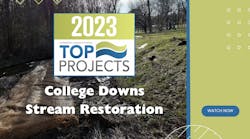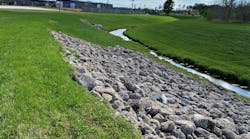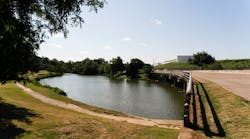CAMBRIDGE, MD (November 11, 2019) — Researchers from the University of Maryland Center for Environmental Science have published a study on the impact of the Conowingo Dam on water quality in the Chesapeake Bay. The scientists used field observations, long-term monitoring data, and model results to better understand the potential impacts of nutrient pollution associated with sediment transported from behind the Dam into the Bay. The study, "Influences of a river dam on delivery and fate of sediments and particulate nutrients to the adjacent estuary: Case study of Conowingo Dam and Chesapeake Bay," was published in Estuaries and Coasts.
Dams initially starve downstream ecosystems of both sediments and particulate nutrients by trapping them in upstream reservoirs. Eventually, however, these reservoirs fill which increases the delivery of sediment and nutrients to downstream ecosystems, especially during storm events when stored sediments can be scoured. Since its construction in 1928, Conowingo Dam has trapped most of the Susquehanna River watershed sediment and associated particulate nitrogen and phosphorus before entering the Chesapeake Bay. However, its storage capacity has significantly decreased, which raises questions about the potential impacts on Bay ecosystems.
The researchers found that most sediment and particulate nutrient impacts to the Bay occur during high-flow events—like during major storms—which occur less than 10% of the time. In the upper Chesapeake Bay, the sediment and nutrients loads delivered during low flows have decreased since the 1970s and loads during large storm events have increased.
During non-storm-event flows, most sediment delivered past Conowingo comes from the Susquehanna watershed. This decrease reflects efforts to reduce watershed loads through BMP installation.
"While storm events can have major short-term impacts, the Bay is actually really resilient, which is remarkable," said the study's lead author Cindy Palinkas, associate professor at the University of Maryland Center for Environmental Science. "If we are doing all of the right things, it can handle the occasional big input of sediment."
The increase in sediment and attached nutrient loads over time during event flows is consistent with a decreasing scour threshold in the reservoir. This is also consistent with decreased trapping of watershed sediment as it passes through the reservoir. Both a lower scour threshold and decreased trapping probably drive the observed increase.
The potential impacts of reservoir sediments on Bay water quality are limited due to the low reactivity of scoured material, which decreases the impact of total nutrient loading even in extreme storms. Most of this material would deposit in the low salinity waters of the upper Bay, where rates of nitrogen and phosphorus release from sediments into the water are low.
However, increased flows during a major storm event can transport fine reservoir sediment to the mid-Bay region, where waters are saltier and lower in oxygen during summer. These conditions could allow for higher rates of nutrient release from sediments.
While large events can have significant short-term impacts, due to ongoing restoration and the time gaps between storm events, the Bay is resilient in the longer term. Major storm events can deliver enormous amounts of sediment to the Bay, but they occur infrequently (less than 10% of the days since 1978). Sediment delivery to the mid-Bay region, where waters are saltier and more conducive to nutrient releases from sediment, is relatively small in magnitude, minimizing potential impacts to Bay water quality.
This synthesis project was supported by Maryland Sea Grant, the Grayce B. Kerr Fund, and Exelon through the Maryland Department of Natural Resources.
For more information, visit the University of Maryland Center for Environmental Science website.






